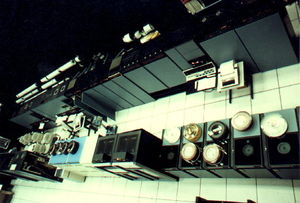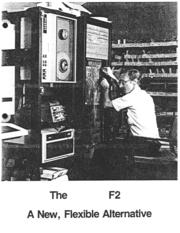Difference between revisions of "Foonly"
From Computer History Wiki
m (Fix Super Foonly link) |
(List F2 users; link to docs at Bitsavers) |
||
| Line 3: | Line 3: | ||
'''Foonly''' was a company which made [[PDP-10]] clones. | '''Foonly''' was a company which made [[PDP-10]] clones. | ||
| − | They | + | They had their own operating system, [[FOONEX]], for their machines; it was based on [[TENEX]]. |
| − | == Computer | + | == Computer models == |
The F-1 was an ECL adaptation of the original [[Super Foonly]] design. The only one was built at [[Information International Inc|III]] for use in an optical character recognition system, and later was bought by Omnibus for generating computer graphics. | The F-1 was an ECL adaptation of the original [[Super Foonly]] design. The only one was built at [[Information International Inc|III]] for use in an optical character recognition system, and later was bought by Omnibus for generating computer graphics. | ||
| − | The F-2 was a small machine. Among other places, it was used at [[CCRMA]] (running WAITS) and Symbolics. | + | The F-2 was a small machine. Among other places, it was used at [[CCRMA]] and the [[S-1 supercomputer]] project (running [[WAITS]]), and [[Symbolics]]. |
| − | The F-3 and F-4 were popular with [[Tymshare]], which built their own versions. | + | The F-3 and F-4 were larger machines, popular with [[Tymshare]], which built their own versions. Tymeshare's System 26KL was an update of the F-4 design with [[KL10]] capabilities, intended to run [[Douglas Engelbart]]'s [[Augment]]. |
| + | |||
| + | [[Image:F2.jpg|300px|left|thumb|The Foonly F2]] | ||
The F-5 was another small machine. | The F-5 was another small machine. | ||
| − | |||
| − | |||
== Peripherals == | == Peripherals == | ||
| Line 21: | Line 21: | ||
* The '''Foonly C1''' was a disk [[channel]] for [[Digital Equipment Corporation|DEC]] computers, compatible with [[International Business Machines|IBM]] drives. | * The '''Foonly C1''' was a disk [[channel]] for [[Digital Equipment Corporation|DEC]] computers, compatible with [[International Business Machines|IBM]] drives. | ||
| + | {{semi-stub}} | ||
| + | |||
| + | <br clear=all> | ||
== External links == | == External links == | ||
| − | * [http:// | + | * [http://www.bitsavers.org/pdf/foonly/ Foonly] - documentation a [[Bitsavers]] |
| + | ** [http://www.bitsavers.org/pdf/foonly/Foonly_Product_Overview.pdf The Foonly "F" Series Computer Family] | ||
| + | ** [http://www.bitsavers.org/pdf/foonly/F2_Brochure.pdf The F2: A New, Flxible Alternative] | ||
* [http://www.bitsavers.org/bits/Foonly/F2/ Foonex monitor, microcode, and working microcode assembler] | * [http://www.bitsavers.org/bits/Foonly/F2/ Foonex monitor, microcode, and working microcode assembler] | ||
* [http://www.bitsavers.org/pdf/sri/arc/augment_engine/26KL_Brochure_Oct83.pdf Tymshare's System 26KL] | * [http://www.bitsavers.org/pdf/sri/arc/augment_engine/26KL_Brochure_Oct83.pdf Tymshare's System 26KL] | ||
| − | + | * [http://dave.zfxinc.net/f1.html Dave Sieg about the F-1] | |
| − | |||
[[Category: Computer Manufacturers]] | [[Category: Computer Manufacturers]] | ||
[[Category: PDP-10 Users]] | [[Category: PDP-10 Users]] | ||
Latest revision as of 03:14, 5 February 2025
Foonly was a company which made PDP-10 clones.
They had their own operating system, FOONEX, for their machines; it was based on TENEX.
Computer models
The F-1 was an ECL adaptation of the original Super Foonly design. The only one was built at III for use in an optical character recognition system, and later was bought by Omnibus for generating computer graphics.
The F-2 was a small machine. Among other places, it was used at CCRMA and the S-1 supercomputer project (running WAITS), and Symbolics.
The F-3 and F-4 were larger machines, popular with Tymshare, which built their own versions. Tymeshare's System 26KL was an update of the F-4 design with KL10 capabilities, intended to run Douglas Engelbart's Augment.
The F-5 was another small machine.
Peripherals

